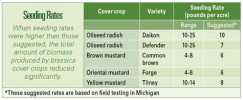The Organic Report: The Potential Of Brassica

Brassica (a.k.a. mustard) cover crops used commonly in agri-cultural production include oilseed radish, brown mustard, oriental mustard, yellow mustard, turnip, and rape. These cover crops provide multiple benefits in cropping systems. Brassica species produce glucosinolates, which are secondary metabolites used by plants to defend themselves against biotic and abiotic stresses.
Upon hydrolysis of glucosinolates, chemicals are released from brassica plant tissue, in which isothiocyanates, thiocyanates, and nitriles are known to be active. They suppress pests, including insects, nematodes, weeds, and fungi. Because of the ability of brassica species to produce those volatile toxic compounds, brassica cover crops are also called biofumigants.
The Breakdown Process
The process of breaking down brassica cover crop tissues to release toxic volatile compounds and incorporating them in the soil is called “biofumigation.” When managed adequately, biofumigants have helped reduce populations of nematodes, weeds, and diseases in cropping systems. The following tips will help maximize the benefits of biofumigants:
1. Use a species or cultivar with high glucosinolates content.
2. Maximize biomass production (appropriate seeding rate and time).
3. Break down plant tissue to trigger the glucosinolate-myrosinase reaction (a flail mower will do an excellent job).
4. Incorporate the residue immediately because most of the break-down products are volatile.
5. Seal the soil surface (with irrigation or a packer if possible).
6. Observe a cash crop plant back period of at least two to three weeks (depending on the crop).
Seeding Rate And Weed Populations
In field trials, the total amount of plant residue (biomass) produced by brassica cover crops reduced significantly when seeding rates were higher than those suggested. For oilseed radish, for example, the optimum seeding rate was 7 pounds per acre for the cultivar Defender and 10 pounds per acre for the cultivar Daikon.
In addition, a study comparing metam sodium (Sectagon, Tessenderlo Kerley) fumigation with mustard biofumigation showed that metam sodium reduced both weed density and dry weight. Metam sodium treatment gave a visual weed control rating of 86%. The brassica cover crops also helped reduce weed populations.
However, the level of weed suppression was limited (visual weed control rating of less than 10%), especially during the cash crop growing season and was not adequate for season-long weed management.Therefore, other weed management tools should be used to supplement the use of brassica cover crops.
Determining Crop Yield
An on-farm study in Hamilton MI, comparing the performance of celery after various cover crops showed that plants from the cereal rye plots were shorter and smaller compared to other treatments.
The brassica cover crops improved celery yield (untrimmed weight, weight after trimming, marketable yield, and stalk number) compared to cereal rye and control treatments. The brassica cover crops increased celery marketable stalk number by 8.2% to 12.9% and marketable weight by 19.0% to 21.4% compared to the control treatment.
In an onion trial, brassica cover crops significantly increased onion total yield on muck soil. Onions in the yellow mustard and oilseed radish treatments had higher total marketable yield compared to the control. Additionally, onion stand was improved significantly after the cover crops.
Cover Crop Vs. Methyl Bromide
A study comparing brassica cover crops — used as biofumigants — to methyl bromide for muskmelon production showed significant stand reduction in the muskmelon. Direct-seeded melon stand was less than 5% in the cover crop plots compared to 85% to 88% in the methyl bromide and control plots.
Melon injury was likely due to the biofumigation effect of the cover crops and more specifically to the short plant back period of eight days between biofumigation (cover crop incorporation) and melon seeding.
Nematode Populations
Studies were conducted on muck soils to test the effect of brassica cover crops on plant parasitic nematodes (root-knot nematodes, pin nematodes, and cyst nematodes). There was low population of plant-parasitic nematodes in the onion field, and cover crop treatments did not affect their counts. The oilseed radish and oriental mustard increased the population of bacterial feeding nematodes compared to the yellow mustard, sudangrass, and control treatments. Sorghum sudangrass plots had more mycorrhizal fungi than all other treatments.
In the celery experiment, oilseed radish reduced plant-parasitic nematode populations by 55.7% and increased bacterial feeders by 262% compared to the control treatment. There was no difference among the treatments for mycorrhizal fungi and oligocheates populations, due to large variations in the data.
The Potential Of Brassica
Brassica cover crops have shown excellent potential for use as biofumigants in vegetable cropping systems, especially for production on muck soils. However, a one-size-fits-all concept does not apply. Poor stand establishment of the melon Athena was observed (on mineral soils) after biofumigation. This problem was exacerbated when the crop was sown too soon after the biofumigation process. Therefore, growers should allow at least two weeks (preferably more than three weeks) between brassica cover crop incorporation and crop planting.









